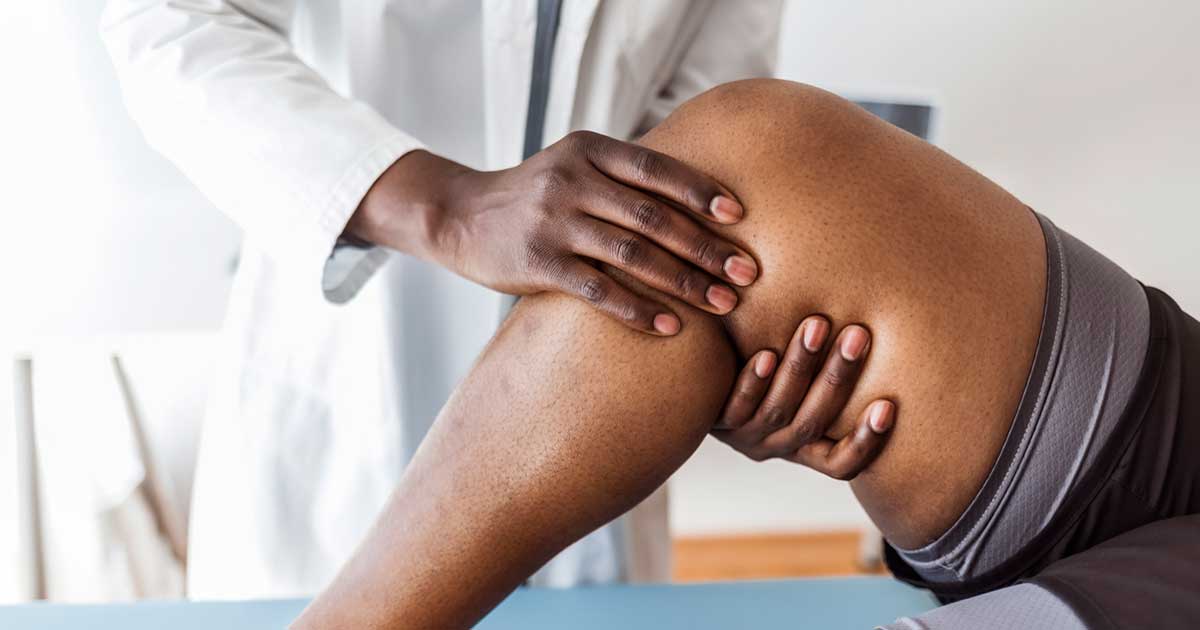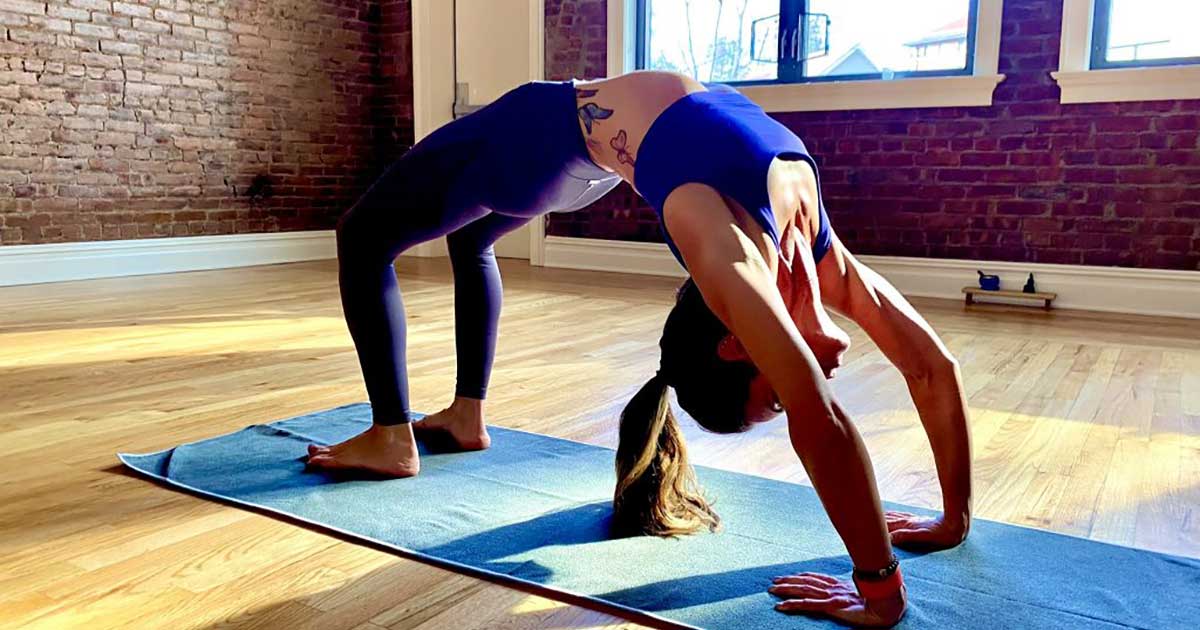
Advice to improve your movement, fitness, and overall health from the #1 in orthopedics in the U.S.
After 20 Years of Kneecap Dislocations, Back to Sports, Pain Free
Adriana Forney was an avid athlete who suffered years of knee pain, until she received a partial knee replacement at HSS.
Advice to improve your movement, fitness, and overall health from the #1 in orthopedics in the U.S.

Adriana’s original problem, called patellofemoral instability (a dislocating kneecap), would cause the kneecap to shift out of its groove. Every dislocation would further damage the cartilage in her knee. Because she did not have surgery and continued to have unstable kneecaps throughout her life, she developed arthritis in her knees at a younger age than most people do.
“Because she never had the dislocations fixed, she eventually wore down the cartilage in her knees and developed arthritis early on,” says Adriana’s orthopedic surgeon, Beth Shubin Stein, MD, Co-Director of the Women's Sports Medicine Center (WSMC) at HSS. The team of specialists at WSMC offers compassionate and comprehensive orthopedic care – from surgery and physical therapy to sports psychology and nutrition – to help female athletes of all ages and abilities resume or continue the activities they enjoy.
According to Dr. Shubin Stein, a significant uptick in knee injuries has been observed in young girls and women as they have become more involved in recreational and high-level sports over the years. “The more hours you spend on the field practicing or playing a competitive sport, the more at risk you are for experiencing ACL tears, patella dislocations, and knee pain,” she says. In fact, females involved in sports are four to nine times more likely than males to suffer from an ACL tear. “Women tend to land and jump from a more upright position, and the less bent your knee is, the higher your risk is to have those injuries,” adds Dr. Shubin Stein.
Living with Chronic Pain
Adriana first dislocated her right kneecap and tore her medial patellofemoral ligament (MPFL) in her early 20s. Soon after, her other knee began dislocating as well. Imaging showed that fluid was accumulating under the kneecap and the cartilage was gone, meaning her bones rubbed against each other.
“I was recommended for knee surgery, but back then I didn’t know anyone who had knee surgery and made a full recovery,” she says, adding that she worried this operation might leave her worse off than she was before. “I was terrified that I would not be able to rebound from surgery, and no matter how hard I worked to get my strength back, I would never be able to play sports again.”
Living with pain was not new to Adriana. She had several major surgeries and even a traumatic brain injury in 2011. Playing sports and being active was her way of reducing stress, especially as she rehabbed after the brain injury.
“I didn’t have to think about how to play lacrosse or field hockey or try to remember how to swim or snowboard—my body always knew what to do, and it was a relief to engage in activities that came naturally,” explains Adriana, who continued to push through despite living with chronic pain. “Those activities were important for my mental health. I feel like I’m my best self when I’m on a field, on a court, in the water, or on a yoga mat. Those are my happy places.”
The perception that it’s difficult to recover from knee surgery persists, but it’s not necessarily true. Many people are not aware of how much technology, surgical techniques, and rehabilitation has changed to help ease recovery.
“Over the last 30 years, we have significantly improved our surgical techniques, which now allow us to move the knee much faster after surgery,” Dr. Shubin Stein explains. “We end up with less stiffness than we used to because we don’t have to immobilize the patient. Instead of casts, we use removable braces, and our priority is to try to get people moving as quickly as possible so they don’t end up with a stiff joint.”
When Nonsurgical Treatments Fail
Eventually, Adriana’s knee pain became too much for even her to bear. She could no longer hold her own weight or squat down. She could barely bend her knees to sit and would basically drop the last few inches onto a chair or toilet. “I would have to use my arms to get out of a seated position,” she said. “I couldn’t go on like that.”
Adriana sought out a local orthopedic specialist who began treating her with a series of injections of a synthetic substance called hyaluronic acid, which mirrors the normal cartilage fluid in the knee and is used to lubricate the joint. It helped in the beginning, allowing her to continue to move and play sports without excruciating pain, but the relief did not last.
This initial focus on nonoperative approaches is common for many patients. Indeed, Dr. Shubin Stein tells her patients that there is no reason to do surgery if nonsurgical treatments are helping them get back to the quality of life they want.
Adriana continued with the injections and other medications along with over-the-counter pain relievers and icing the knee, hoping that these would control her pain enough to keep active and avoid surgery. “My doctor kept asking me to consider knee replacement, but I was afraid that it would lay me up and I would be benched for the rest of my life,” she recalls.
When Adriana finally exhausted her options, her doctor referred her to Dr. Shubin Stein, who has more than two decades of experience at HSS in arthroscopic and reconstructive surgery of the knee. She is among only a handful of orthopedic surgeons in the country who are skilled in treating Adriana’s unique combination of arthritis and patellofemoral instability.
Dr. Shubin Stein also conducts research on patella instability to find better ways to help patients in the future. She and colleagues in the Patellofemoral Research Center at HSS are evaluating current surgical techniques and aiming to develop better treatments that enhance quality of life for patients suffering from knee pain and instability.
Choosing Surgery
“A combination of physical therapy and injections usually does the trick, but Adriana is such a competitive, high-level performer that she didn’t get enough pain relief with these options,” says Dr. Shubin Stein. “Generally, if you are accommodating your life to your knee and pain is causing you to lose out on the things that make you happy or keep you active, then it’s time to consider surgery.”
Because Adriana had no remaining cartilage and her arthritis was so severe, she would need a combination of approaches to provide long-term stability and pain relief. Dr. Shubin Stein recommended partial knee replacement and ligament reconstruction for each knee. “This combined solution would provide Adriana with much-needed pain relief and ensure that the kneecap would remain stable and not continue to dislocate over time.”
Recovering with Physical Therapy
Adriana wanted to have both knees done at the same time so she could snowboard in the winter and compete in the tennis season the following spring. Because this type of surgery requires a removable brace for approximately six weeks and the length of recovery would be about six months, it would not be feasible to do these together. But Dr. Shubin Stein agreed to push up the second surgery if Adriana hit her physical therapy goals in half the time.
It was ambitious, but with the help of HSS physical therapist Michelle Cilenti, Adriana pulled it off, doing extra workouts and strength training on her own at home.
“Michelle became a friend and she got to know me quite well. We worked very well together,” says Adriana. “She quickly came to understand my personality and that I didn’t want to follow a standard path. I needed an accelerated plan.”
Her second surgery was scheduled in early December, three months after her first. Afterward, Adriana was equally determined to be able to complete her physical therapy as quickly as possible and she succeeded in getting back on the tennis court in time for the first day of the spring season.
“The role that a physical therapist plays in a patient’s recovery is vital,” notes Dr. Shubin Stein. “A good surgery result is important, but without great physical therapy, it doesn’t work.”
Regaining Quality of Life
Adriana is back to doing all the things she loves and often finds herself talking to others about her experience. When she encounters people who are hesitant to have knee surgery, as she was for so many years, she understands their fears and offers valuable perspective.
“I can do everything now—going up and down stairs, jumping, lunging, and playing tennis for hours with no issues,” she says, adding that now that pain is no longer keeping her sidelined, she wishes she had not put off surgery for so long.

Dr. Shubin Stein says it’s normal to have concerns around having an operation, but information is key to reducing that anxiety, which may not always be justified. “I think that the biggest hurdle is finding the right doctor and the right hospital, and then making that first appointment,” says Dr. Shubin Stein. “You have absolutely nothing to lose by coming in for a consultation and getting your questions answered.”
Published 2/13/2023


